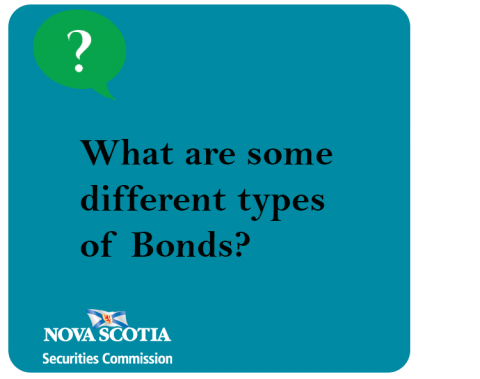Submitted by nsscadmin on

As we said in a previous blog post, a bond is essentially a loan you are making to a company or the government. The bond is secured by the government’s tax base or by a company’s assets. The term on a bond can typically range from a year to 30 years. Interest on the bond is usually paid at a fixed rate. This rate is determined by current interest rates and the credit rating of the bond issuer.
We’ve received a few questions about bonds lately, so over the next three weeks during Investor Education Month we’ll be educating our readers on bonds. This week we’ll look at a few different types of bonds and how they differ from regular bonds that simply collect interest until they mature.
Strip Bonds
Strip bonds are different than regular bonds in that they may not pay interest. Investors buy them at a discount and they mature at their face or principal value.
A regular bond pays you interest, also known as coupons. Strip bonds have their coupons separated, or stripped away and sold separately as another form of security. The remainder of the bond after the coupons are stripped away is called the residue.
Both the coupons and the residue are sold at a discount to investors. For example, let’s say an investor purchase a bond residue for $3000 and the face value of the bond is $5000 and is set to mature in five years. At the maturity date the return on the residue is $2000 ($5000-$3000).
If an investor purchases the coupon it works a little differently. On the same $5000 bond an investor purchase one semi-annual coupon. The interest on the bond is 4% and it’s paid twice a year. That could be calculated as (4%/2) X $5000 = $100. The investor would pay ($3000/$5000) x $100 = $60. The return at maturity would be $100 - $60 = $40.
Index Bonds
Index bonds are different in that they keep pace with inflation. They follow the Consumer Price Index, and as it goes up, so does the interest rate on your bond. Conversely if the Consumer Price Index goes down, so does your interest rate.
Here’s an example of how it works compared to a regular bond.
Let’s say I buy a regular $100 bond with a 5% interest rate and a one-year maturity rate, and a $100 Index bond which also has a 5% interest rate and a one-year maturity rate. At the time of purchase the consumer price index is at 130.
A year later the regular bond is worth $105 with the interest accrued. The consumer price index is now 134 so for the index bond the interest must be adjusted for inflation. That is done by dividing the new consumer price index by the old one – 134/130 = 1.0307. The inflation rate is 3.07%. So, $105 X 1.0307 = $108.22. This what the holder of the index bond would receive when it matures.
Real Return Bonds
Real return bonds are issued by the government of Canada and are also adjusted for inflation. However, they are adjusted differently than Index Bonds. Twice a year you receive interest payments that are adjusted to the consumer price index and when the bond matures the face value is also adjusted for inflation.
